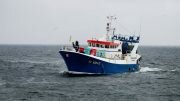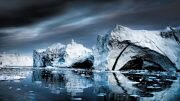According to researchers, Greenland was actually green once upon a time – about 400,000 years ago.
Greenland is the world’s largest island and is almost completely covered by a layer of ice. If all the ice were to melt today, the sea level would rise by about seven meters. But relatively recently – from a scientific time perspective – the island was free of ice and covered by lush nature.
Tests of soil samples from the American Greenland base Camp Century show that this was the case around 400,000 years ago. The samples were taken by the US military, which drilled down through a 1,400-meter thick layer of ice in the 60s.
Lying on ice
For unknown reasons, the soil samples were frozen and stored in Denmark. Only in 2017 were they finally analyzed by a team from the University of Vermont. Geologist Paul Bierman says he found something in the ground he could not identify, and he asked colleague Andrew Christ to take a look.
“He looked down into the microscope and made an exclamation. It was a branch piece, which had been under a kilometer-thick layer of ice. Incredible!” Bierman said to the news agency AFP.
Bierman and colleagues are presenting their findings from the study in the renowned research journal PNAS. They believe that the soil samples date from a time when Greenland was covered with moss, lichen, and perhaps even trees.
More fragile than expected
If humans continue to burn fossil fuels, they could reach the threshold where they would experience extensive ice melting much faster than previously thought.
“Our findings tell us that the ice sheet in Greenland is fragile,” Bierman said.
“This is not a problem for the next 20 generations, but for the next 50 years,” the researcher emphasized.
Consequences for coastal areas
The current forecast from the United Nations’ Intergovernmental Panel on Climate Change (IPCC) estimates that sea levels will rise by around one meter until the turn of the century, i.e., when today’s children reach old age.
Hundreds of millions of people will be affected in low-lying areas worldwide, including coastal areas in Scandinavia.
In Norway, the rise of the sea level is expected to have the greatest consequences in Sørlandet, Vestlandet, Lofoten, and Finnmark, according to the Norwegian Environment Agency’s 2015 report “Sea Level Change for Norway.”
Source: © NTB Scanpix / #Norway Today / #NorwayTodayNews
Do you have a news tip for Norway Today? We want to hear it. Get in touch at [email protected]





Be the first to comment on "Greenland has been ice-free before – researchers worry it could happen again"